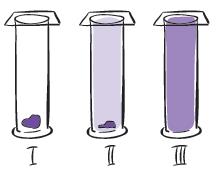Asia-Pacific Forum on Science Learning and Teaching, Volume 18, Issue 1, Article 3 (Jun., 2017) |
This section presents the ratios of the students’ responses to the open-ended questions based on the categories mentioned above. First the questions will be presented and then the ratios of the responses. The first open-ended question was as follows:
While fishing, Yiğit lost his balance and fell into the river. Some friends of Yiğit made the following recommendations to him for drying his wet clothes:
Ali: It is sufficient to dry them in the sun, because water evaporates at any temperature.
Yunus: Water boils at 100°C and only evaporates at this tempereature. Therefore, you need to heat your clothes at 100°C, if you want to dry them.
Beyza: You should take off your clothes immediately, or you will get cold.
Tuba: Your clothes do not dry when you are wearing them. You should hang them out to dry on the balcony.Among the responses to the first question, the response “He should follow Ali and Beyza’s recommendations” was considered to be in the full understanding category, because evaporation occurs at any temperature. Furthermore, Yiğit should also take off his clothes immediately since the wet clothes will cause him to get cold. The responses stating that he should only follow Ali’s recommendation were placed into the partial understanding category, while the other responses indicatedmisunderstanding. One of the responses in the full understanding category was as follows: “…He should do what Ali and Beyza says. Ali’s idea is right, because water evaporates at any temperature. Beyza’s recommendation is also true, because clothes need heat to dry and they get that heat from the body...”. One of the responses in the partial understanding category was as follows: “…Since water evaporates at any temperature, Ali is right. Beyza is also right, because if Yiğit does not take off his wet clothes, moisture passes to his body…”. One of the responses in the misunderstanding category was as follows: “…He should take off his clothes and hang them out on the balcony, because they dry when they are hung...”. Table 2 shows the distribution of the responses.
Table 2. Ratios of the responses to the first question
Full Understanding
Partial Understanding
Misunderstanding
Unanswered
33%
49%
16%
2%
The second question was as follows:
Yunus Emre was playing basketball. His mother saw that his uniform was wet with sweat. She told him to change his uniform and towel himself so that he does not get cold. Please explain the reason why Yunus Emre will get cold if he does not take off his wet uniform.The students were expected to explain the reason as follows: “While the wet uniform is drying, it draws heat from Yunus Emre’s body, causing him to get cold”. Responses similar to this were placed in the full understanding category. On the other hand, those such as: “Water will get dry on his body”, were included in the partial understanding category, while other responses indicated misunderstanding. One of the responses in the full understanding category was as follows: “...Since sweat is made up of water, the body’s heat exchanges with sweat, causing Yunus Emre to get cold…”. One of the responses in the partial understanding category was as follows: “...because water will dry on his body…”. One of the responses in the misunderstanding category was as follows: “…After a while, his dampened uniform will get cold due to the effect of wind, causing him to get cold…”. The distribution of the responses to the second question is as follows:
Table 3. Ratios of the responses to the second question
Full Understanding
Partial Understanding
Misunderstanding
Unanswered
14%
8%
76%
2%
The third question was as follows:
On a spring day, Fatma heard while watching the news on the TV that the stream in their village located on the slopes of a high mountain where she and her father went fishing in the summer overflowed, leaving the croplands around the village underwater. She was curious about the reason why the stream overflowed. Then she remembered that the mountain had been covered with snow during the winter. How do you think Fatma explained the overflow? Please explain in detail.Responses indicating full understanding would be something like: “Snow melts and changes from a solid to a liquid state. It might be the reason for the overflow.” Responses such as: “Snow fills the stream with water” were included in the partial understanding category, while the other responses indicated misunderstanding. One of the responses in the full understanding category was as follows: “…When the sun rises, snow melts and those places are submerged…”. One of the responses in the partial understanding category was as follows: “…snow fills the stream with water…”. One of the responses in the misunderstanding category was as follows: “…since there are heavy rains in the spring, streams overflow…”. Table 4 shows the distribution of the responses to the third question.
Table 4. Ratios of the responses to the third question
Full Understanding
Partial Understanding
Misunderstanding
Unanswered
57%
8%
25%
10%
The fourth question was as follows:
Mahmut went to his garden in the early hours of the morning and saw that there were water droplets on the tomatoes, although it was not raining. When he came by the garden again in the afternoon, he did not see any water droplets. What do you think the reason for these two situations is? Please explain in detail.The students were expected to express the idea that there were drops of dew on the tomatoes during the early hours of the morning and then the layer of dew evaporated. Such responses were included in the full understanding category. The responses that contained information only about the formation of dew or about evaporation were placed in the partial understanding category. One of the responses in the full understanding category was as follows: “…There were drops of dew on the tomatoes due to the weather, then they evaporated when it got warmer…”. One of the responses in the partial understanding category was as follows: “…The reason is that the rain drops on the tomatoes evaporated after a while. Therefore, the drops on the tomatoes disappeared…”. One of the responses in the misunderstanding category was as follows: “…It is because of the process of sublimation. Sublimation is the transition of a substance from the gas to the gas phase due to the loss of heat…”. Table 5 shows the ratios of the responses to the fourth question.
Table 5. Ratios of the responses to the fourth question
Full Understanding
Partial Understanding
Misunderstanding
Unanswered
18%
38%
39%
5%
The fifth question was as follows:
There is solid iodine in the first tube with the lid on. The state of iodine changed as shown in the second picture after 10 min and in the third picture after 30 minutes without any moisture. Which phase change occurred during this period? Please explain your reasons in detail. The students were expected to state the reason as “sublimation”. Such responses were included in the full understanding category. Some of the students said that sublimation occurred only when the substance changed from state I into state II. Such responses were included in the partial understanding category, while the other responses were placed in the misunderstanding category. One of the responses in the full understanding category was as follows: “…There was no air inside the tube and iodine started to evaporate slowly after 10 min. After 30 min, iodine evaporated completely…”. One of the responses in the partial understanding category was as follows: “…The reason is evaporation, because heat decreases as time passes…”. One of the responses in the misunderstanding category was as follows: “…These changes, iodine absorbed heat and first melted after 10 min, and then completely turned into a water state after 30 min…”. Table 6 shows the ratios of the responses to the fifth question.
Table 6. Ratios of the responses to the fifth question
Full Understanding
Partial Understanding
Misunderstanding
Unanswered
22%
9%
66%
3%
The sixth question was as follows:
Ahmet ran into the situation shown in the following images. He saw that the leaves and the windshield of his car were as shown, when he went out to work in the morning. How do you think Ahmet explains this situation? Please explain your reasons in detail.
The students were expected to express the fact that it was due to deposition which occurs when a gas becomes a solid without going through the liquid state of matter. Such responses were included in the full understanding category. The responses of the students who were not able to explain how deposition occurs were included in the partial understanding category, while the responses including irrelevant information were placed in the misunderstanding category. One of the responses in the full understanding category was as follows: “…Deposition is the process where water vapour from air deposits directly into a solid…”.One of the responses in the partial understanding category was as follows: “…The weather got cold and lost heat. Therefore, it got cold and then the water particles froze, leading to the formation of small particles…”. One of the responses in the misunderstanding category was as follows: “…The leaf froze due to the air pressure. The windshield of the car froze as the vapour in the air condensed…”. Table 7 shows the ratios of the responses to the sixth question.
Table 7. Ratios of the responses to the sixth question
Full Understanding
Partial Understanding
Misunderstanding
Unanswered
23%
29%
43%
5%
The seventh question was as follows:
In the winter, a large bowl of water is put at the exact centre of fruit and vegetable warehouses. What could be the reason for this? Please explain your reasons in detail.The students were expected to say that heat is released when water freezes into ice, thus the fruits and vegetables are kept from freezing. Such responses were included in the full understanding category. The responses which only stated the necessity of putting a bowl of water in order to prevent fruits from freezing were included in the partial understanding category, while other responses were placed in the misunderstanding category. One of the responses in the full understanding category was as follows: “…When water freezes, it releases heat to the fruits, thus fruits do not freeze…”.One of the responses in the partial understanding category was as follows: “…It is done to prevent fruits from freezing…”.One of the responses in the misunderstanding category was as follows: “…It is done to prevent foods from spoilage…”. Table 8 shows the ratios of the responses to the seventh question.
Table 8. Ratios of the responses to the seventh question
Full Understanding
Partial Understanding
Misunderstanding
Unanswered
24%
9%
63%
4%



